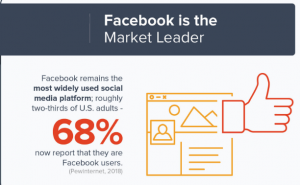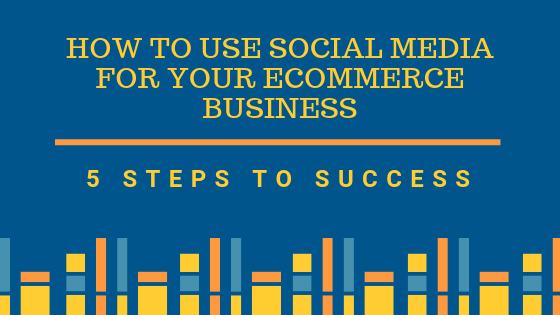Today we’re going to talk about how to use social media to grow your eCommerce business. Did you know that there are 3.4 billion people use social media worldwide actively? Even more impressive 65% actually use social media to purchase products. If you think that social media isn’t important for your eCommerce business, you’re dead wrong. It’s time to think again.
Step #1 -To choose your platform.
Now the obvious choice is Facebook, and this makes a lot of sense because three-quarters of those sales actually come from Facebook’s platform. Social Media statistics.

However, there are other platforms that may make sense for your business. You might want to look into Twitter, LinkedIn, Instagram, Pinterest, or the myriads of others that are out there. By identifying your demographics, identifying where your customers are, and what they’re looking for, you can choose other social media platforms aside from Facebook.
You don’t always want to put everything in one basket, but understand you want to build from Facebook as your foundation because that’s where most of the users are. And then build above that and build beyond that where more of your customers are in more of that niche program. By focusing on those, you can understand where your customers are looking, where they’re shopping, what they’re shopping for.
- Are they researching?
- Do they actually buy?
- Are they looking for DIY or information?
Understand that, focus them in on your social media, and then keep in mind in these next steps we’ll talk about how to craft a content strategy.
Bonus Tip– When you’re creating your social media platforms and all of these presences, you want to make sure you’re taking the retargeting code or the audience code from each of these platforms and placing it on your website. This is going to become extremely important. So start doing it here so these lists have a chance to build and you have an opportunity to gather this data right in the very beginning.
Step #2-Ensure brand consistency.
You want to make sure that whatever platform you’re on matches the core brand. Now the core of your brand may be your store or your storefront, it may be your website, it may be something else, but you want to make sure your social media presence also matches. You want to make sure you’ve got the same logo, same colors, same voice, same content, same copy.
By making sure your social media platforms and your website and your store and anything like that all kind of integrate with each other you can develop some consistency. And consumers love consistency.
It helps them trust your business. And by ensuring that everything is related across your platforms, you’re able to make sure they have the same experience regardless of where they are. If they come into your store or they go to your website or they go to your local media pages, they should have the same experience as if they were speaking to you face to face. Or the same experience if they were using your main sales channel.
So make sure you spend a little bit of time here and make sure your branding, your color, and your logo and your content, copy and voice and everything is the same as they would experience from your main sales platform. Do this early. Do it now. And that way you can help to increase your sales over time.
Step# 3- Develop a content strategy and a consistent calendar.
Again, consumers love consistency and this ensures that you are held to a standard. If you say that you’re going to post every Monday at 9 a.m. stick to it. And make sure that you are able to take time, and you are able to spend the energy that you need to in making sure that your posts are ready to go. Your consumers will start to get used to this. They’ll start to get used to seeing a video at 12:00 every Tuesday. You can get help from my post Content that attracts customers.
They’re going to get used to that webinar at 1:30 every Wednesday. Once they get used to this, they’re going to start looking for it. So, not only are you providing some consistency for them, but you’re also providing consistency for yourself. If you just try to go off the hip, you’re going to find that you never really just take the time. And consistency is key when you’re growing a social media platform.
You have to make sure you’re posting, you’re engaging, you’re spending the time that is necessary to get these people to engage with you. There’s a lot of money to be made on social media, especially for eCommerce businesses, so you have to make sure you spend the time here. It may take a little time and energy up front, but it’ll pay dividends in the future.
Step#4- Focus on ads.
Now, remember back in the beginning when you first set up your social media profiles you connected the analytics, you connected the audience code or the retargeting code to your website. Now, depending on the amount of traffic that your eCommerce website is getting it may take some time and different Social media platforms will have different needs or different restrictions. Based on the size of the audience that’s required before you can actually start running ads against it.
97% of people do not convert the very first time they visit a website. So if you’ve been building these lists over time you can now use them as a part of your targeting campaign. And retargeting is creating top of mind awareness for people that need to come back to your site.
You already spent the time, money and energy to get them there and by investing in retargeting on your social platforms you’re able to drive them back to the site.
Remind customer-;
1.Why they visited the first time.
2 Remind them of your product.
3. Also, remind them of the need that they have that you’re able to fill.
So spend the time and energy wisely. Create ads that are specific to driving people back to your site. This is the targeting campaign.
Bonus Tip-Now bonus tip here is obviously to run an ad campaign to bring in new people.
You do that on Google, Facebook, YouTube, Bing, all over the place. Use that to drive new people to your site. Your targeting campaigns are to bring people back.
1. It could be consumers that have already purchased. And you can offer them a reason to come back and purchase again.
2. Specifically targeting people that came to your site and didn’t purchase.
Again, 97% of people won’t so you don’t want to lose them. Target the 97%, bring them back to your site via your social media channels and you’ll see your revenue increase.
Step#5- Always stick with it.
Finally, I want to encourage you to stick with it. Facebook wasn’t built in a day. So it takes some time, takes some energy, takes some consistency to see the results that you’re looking for. Just like organic growth as you would normally see on Google or Bing, this takes some time. Just because you create a Facebook profile doesn’t mean that overnight you’re going to become an immediate success.
You have to spend some time and energy here. By doing so, you end up building up your brand and you get to expand where your business is reaching. Not everybody is searching for you on Google. And everybody is finding you on Twitter. Also, everybody is finding you on Instagram or Facebook.
So by focusing here on the different channels that we already chose back in the very beginning. By building up your audiences and targeting lists, by running some ads, bringing people to your social profiles you can take advantage of social media channels.
If you have any other suggestions or strategies that we may have missed, please leave them in the comments.
